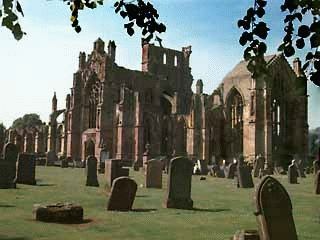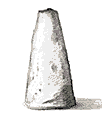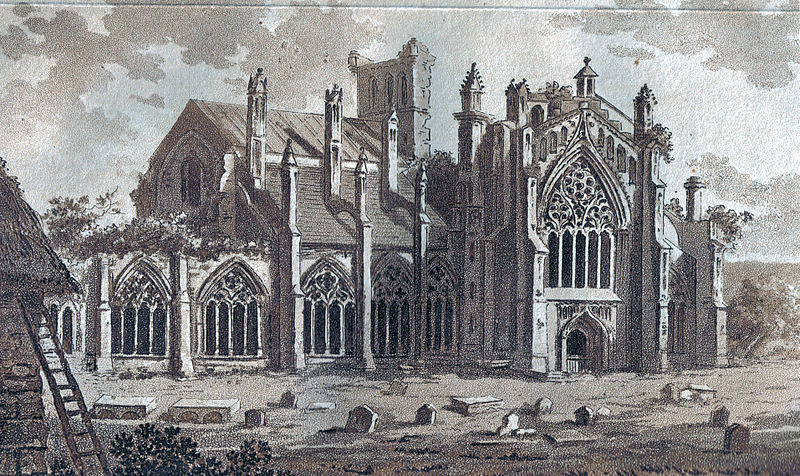 The original site of the Abbey was 4 miles down the River Tweed, just below Scott's View. Founded by St Aidan in about A.D. 660, it's first prior was St Boisil who was succeeded by St Cuthbert, the apostle of the Borders, who dwelt there until 664 when he became prior of Lindesfarne. Later, when St Cuthbert died, it became one of his resting places before his body was taken to the place where Durham Cathedral was founded. Then in 1131, David I, King of Scots, encouraged the Cistercian monks who had been sent by Bernard of Clairvaux from France to found a new abbey on the present site below the Eildon Hills. It was dedicated to the Blessed Virgin on Sunday 28 July 1146.
The original site of the Abbey was 4 miles down the River Tweed, just below Scott's View. Founded by St Aidan in about A.D. 660, it's first prior was St Boisil who was succeeded by St Cuthbert, the apostle of the Borders, who dwelt there until 664 when he became prior of Lindesfarne. Later, when St Cuthbert died, it became one of his resting places before his body was taken to the place where Durham Cathedral was founded. Then in 1131, David I, King of Scots, encouraged the Cistercian monks who had been sent by Bernard of Clairvaux from France to found a new abbey on the present site below the Eildon Hills. It was dedicated to the Blessed Virgin on Sunday 28 July 1146.
 Richard II, in retaliation for a raid by the Scots in 1385, sent a force North of the border which "saved nothing and burnt down with fiery flames God's temples and holy places - to wit the monastries of Melrose, Dryburgh and Newbattle" Work started on the complete rebuilding of the abbey almost as soon as Richard's forces had left, and it is the remains of this new building which we see today. The delicacy of carved stone is remarkable. The visitor can spend hours finding carved images and decorative details, some of it high up and thus well preserved;
Richard II, in retaliation for a raid by the Scots in 1385, sent a force North of the border which "saved nothing and burnt down with fiery flames God's temples and holy places - to wit the monastries of Melrose, Dryburgh and Newbattle" Work started on the complete rebuilding of the abbey almost as soon as Richard's forces had left, and it is the remains of this new building which we see today. The delicacy of carved stone is remarkable. The visitor can spend hours finding carved images and decorative details, some of it high up and thus well preserved;
- The Coronation of the Virgin
- The clam shell of St James
- Saints, including St Andrew, St Catherine, St Peter, St Paul, St Thomas
- Dragons, gargoyles, and flowers and plants
- A particularly beautiful sculpture of the Virgin and Child conceived in a 14th century continental style.
- On the lintel of the bell-stair the celebrated master mason John Morow from Paris left his mark and incription: "Be halde to ye hende" ("Keep beholden to, or keep in mind, the end, your salvation") This has become the motto of the town of Melrose.
 There is much of interest in the abbey precinct including the Burial place of Robert the Bruce's heart (brought back from the crusades), and the Commendators House of 1590, now a museum. Restoration of the abbey was carried out under the direction of Sir Walter Scott in 1822. Today the abbey is in the care of Historic Scotland, and is open to the public:
There is much of interest in the abbey precinct including the Burial place of Robert the Bruce's heart (brought back from the crusades), and the Commendators House of 1590, now a museum. Restoration of the abbey was carried out under the direction of Sir Walter Scott in 1822. Today the abbey is in the care of Historic Scotland, and is open to the public:
1 April - 30 Sept, every day, 9.30-6.30
1 Oct - March 31, every day, 9,30-4.30, except Sun, 2-4.30
Melrose Abbey and the mystery of Robert the Bruce's heart
In 1996 an archaeological excavation on the site unearthed a conical lead container and an engraved copper plaque that read "The enclosed leaden casket containing a heart was found beneath Chapter House floor, March 1921, by His Majesty's Office of Works."  Although the lead container was not opened, it is believed to contain the heart of Robert I.
Although the lead container was not opened, it is believed to contain the heart of Robert I.
The smaller conical casket is about 10 inches high and 4 inches in diameter at the base tapering to a flat top about one and a half inches in diameter. Despite being pitted with age it was in remarkably good condition. Richard Welander, one of the investigating team from Historic Scotland, said that although it was not possible to prove absolutely that it is Bruce's heart, "We can say that it is reasonable to assume that it is". There are no records of anyone else's heart being buried at Melrose. The container was reburied at Melrose Abbey on 22 June 1998. A plinth was unveiled on 22 June which covers the burial site of the container.
About the life of Robert the Bruce
- Son of Robert Bruce, Earl of Carrick and Annandale, and Marjorie, Countess of Carrick
- Born in 1274, was 31 when he became king, he died in 1329 in Cardross, Argyll (probably of leprosy)
- Married Isabella of Mar and then Elizabeth de Burgh. Thier son was King David II
- King Edward I of England regarded him as a traitor
- Edward's comander in Scotland, the Earl of Pembroke defeated him in 1306 at Methven near Perth and he hid amongst the hills and forests. At this time, when all seemed hopeless he saw a spider constantly remaking its web in a cave in which he was hiding. This was the moment at which he vowed to keep trying to free Scotland from the English
- Three of his brothers were executed by Edward.
- With the help of Edward Bruce, Thomas Randolph and Sir James Douglas (the famous "Black Douglas" whose name was used by English mothers to threaten discipline to their children) he gradually and courageously recaptured Scottish castles and land from the English
- Edward II advanced on Bruce's army with 20,000 soldiers
- At Bannockburn, near Stirling, on the 24 June 1314, Bruce's army defeated the English who then fled south of the border.
- When he died in 1329 his body was buried at Dunfermline. His heart was removed and taken on the Crusades by the Black Douglas (Sir James), who, just before he was killed in Moorish Spain had hurled it at the enemy
- The heart was recovered and taken back to Melrose Abbey where the new king, David II (Bruce's son), had asked for it to be buried.
